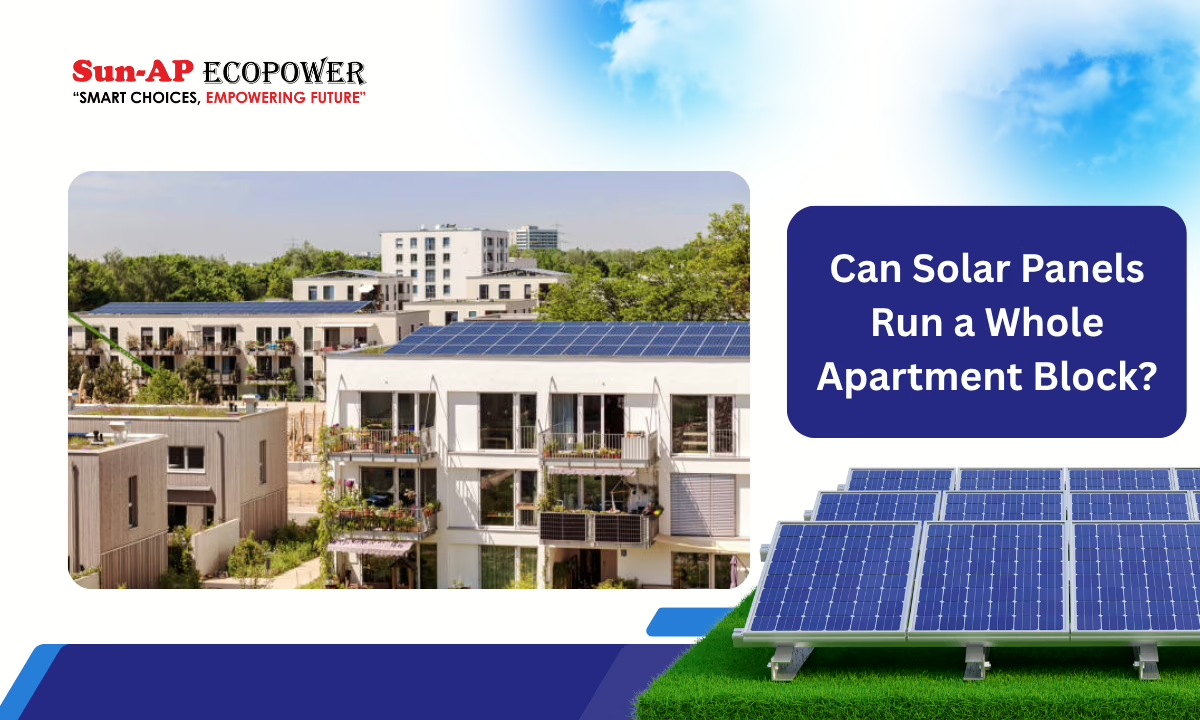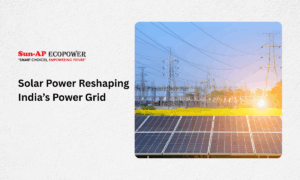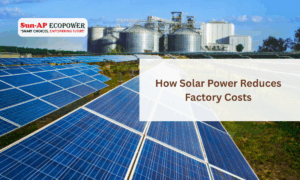As a part of the dedicated team at Sun-Ap Ecopower, today I’d like to walk you through whether solar panels can realistically power an entire apartment complex, covering everything from the types of solar panels available, how they work, what to consider during rooftop solar panel installation, and what the benefits and drawbacks are. Let’s dive in.
Solar panels
When we talk about solar panels, we mean the photovoltaic (PV) modules that convert sunlight into electricity. When you combine a sufficient number of panels with an inverter, mounting structure, wiring, and sometimes batteries, you get a rooftop solar system.
There are different solar panel types you might consider:
- Monocrystalline panels: These are high efficiency, have a higher cost, and are great when roof space is limited.
- Polycrystalline panels: Slightly lower efficiency, but often a more cost-effective choice for larger surface area.
- Thin-film or newer technologies: Less common for large-scale apartment installations, but worth knowing about.
Understanding the efficiency, cost, and manufacturer quality is important — that’s why we always evaluate both the panel specs and the reputation of solar panel manufacturers when selecting gear.
Can an apartment complex be fully powered by rooftop solar?

Yes, in many cases, a well-designed and properly sized rooftop solar system can cover a significant portion of an apartment complex’s energy consumption. Whether it can power 100% depends on multiple factors:
Key factors we consider:
- Available roof area: Is there enough unshaded, structurally sound space on the rooftop (or possibly other surfaces) to install enough panels? Apartment buildings often have more limitations than standalone houses.
- Orientation and sun exposure: For best results, the panels should get good direct sunlight for many hours. Any shading from adjacent buildings, trees, or other structures reduces output.
- Load profile of the complex: Are we powering just common areas (lifts, lights, fans) or are we covering every flat/apartment’s full consumption (air-conditioning, heavy appliances)? The greater the load, the larger the system required.
- System design and efficiency: Efficiency matters — better panels and inverters mean more output per square metre. Also, mounting (tilt, angle) and wiring losses matter.
- Regulatory and grid-connection constraints: For a large apartment complex, you’ll need to consider net-metering, local electrical regulations, society approval, etc.
- Budget and economic feasibility: The upfront cost, payback period and long-term maintenance need to make sense for the society or the apartment association.
In practice, what we at Sun-AP Ecopower often deliver is a system that covers common electrical loads plus a portion of individual apartment loads. With the right investment, some complexes manage to approach full coverage.
Rooftop Solar System for Apartments
Here’s how we approach installation when we help an apartment complex go solar:
Step 1: Site & Roof Assessment
We inspect the rooftop for size, orientation, structural strength, shading, and existing roof obstructions. We check how much energy the building uses (monthly kWh) and decide how many panels and what capacity inverter system will be needed.
Step 2: Select Solar Panels, Inverter & Mounting
We choose from trusted solar panel manufacturers, always focusing on quality, warranty, and performance (efficiency, degradation rate), and consider whether monocrystalline or polycrystalline is better given the roof space. We design a mounting structure (tilt, angle) to maximize output.
Step 3: Permissions & Grid Integration
For apartment complexes, we coordinate with the housing society and, local electricity board/distribution company for net-metering or grid interconnection. We ensure all electrical safety and building regulations comply.
Step 4: Installation
We install the panels, inverter(s), mounting frames, wiring, and any monitoring systems. For large installations, we often include a monitoring dashboard so the apartment society can see how much energy is generated, consumed, and exported.
Step 5: Commissioning & Handover
We test the system, commission it, and train the building maintenance team or society on operation, cleaning, and maintenance needs. We also provide documentation and warranty details.
Step 6: Operation & Maintenance
We recommend regular solar panel cleaning (dust, bird droppings reduce efficiency), monitoring system output, and checking inverter health. Many panel manufacturers guarantee 25 years of performance (with small degradation) and mounting/inverter warranties of 5-10 years or more.
Advantages and Disadvantages of Solar Panels in Apartment Complexes
Let’s look at the advantages and disadvantages of solar panels in this context.
Advantages:
- Lower electricity bills for the apartment society and possibly residents if the system is structured to share savings.
- Greater energy independence and resilience (especially during grid fluctuations).
- Positive environmental impact: fewer carbon emissions, greener image.
- Incentives/subsidies may apply (especially rooftop solar), which improve financial return.
- Increased property value: Buildings with solar installations become more attractive for occupants or buyers.
Disadvantages:
- Up-front capital cost can be high; payback may take years depending on usage, roof size, and panel cost.
- Roof space limitation: Many apartment buildings don’t have large, uninterrupted roof areas or face shading issues.
- Maintenance obligations: While low, panels still need cleaning and periodic inspection; neglect reduces performance.
- Complexity of shared systems: In an apartment complex, you must coordinate with the society, possibly many owners/residents, manage the sharing of savings, and possibly the distribution of power.
- Efficiency drop or degradation over time: Panels lose some efficiency yearly (typically 0.5-1% per year), so system output reduces gradually.
Solar Panels Efficiency & How It Matters
When designing a rooftop solar installation for an apartment complex, solar panels’ efficiency is a key parameter. Higher efficiency panels mean that, given the same roof space, you can produce more electricity. For example, monocrystalline panels typically deliver around 20–22% efficiency or more under ideal conditions. Lower efficiency panels may be cheaper, but if your roof space is constrained (as many apartment buildings are), you might not be able to scale up the number of panels indefinitely. Therefore, at Sun-Ap Ecopower, we often recommend higher efficiency modules for such setups even if cost is slightly higher — because the “per square metre” output is better, meaning higher return on roof space.
We also evaluate the system’s total performance: real-world output factors such as panel tilt, orientation, shading, inverter efficiency, wiring losses, dust buildup, etc. When we quote an apartment society, we estimate how many units (kWh) the system will generate annually, and compare it with the society’s annual consumption to estimate how much of the load can realistically be covered by solar.
Choosing Solar Panel Manufacturers & Dealers in India
In the Indian context, it’s crucial to select reputable solar panel manufacturers and suitable solar panel installation partners or dealers. For instance, there are many Solar Panel & Products Dealers in India who might offer different brands and warranty/after-sales support.
At Sun-Ap Ecopower, we vet manufacturers for:
- Warranty (often 25 years for panels, 5–10 years for inverters)
- Performance guarantee (how much output after 10 or 25 years)
- Local service and availability of spare parts
- Certification and compliance with Indian standards (for example, BIS standards)
- Proven track record and references, especially for large projects (apartment complexes, commercial rooftops)
We also consider installation partners (dealers/installers) who can handle large rooftop installations, coordinate society approvals, local utility net metering, and provide post-installation maintenance.
What We Recommend for an Apartment Complex
From our experience working with apartments, here are our recommendations and best practices:
- Conduct an energy audit: Understand how much electricity the building uses annually (kWh) and map out major load centres (common areas, lifts, lighting, pumps).
- Estimate the amount of roof space available and ideally unshaded.
- Calculate potential output: Based on roof area, panel efficiency, and sun hours per day (for your region), estimate annual kWh generation.
- Decide which loads you aim to cover: e.g., common area only vs all apartment flats. This will determine system size and cost.
- Use higher‐efficiency panels if roof space is limited.
- Choose a reputable manufacturer and installer with proven experience.
- Plan for usage-sharing or billing model: In an apartment complex, one needs transparency on how the solar savings are allocated among residents or the society.
- Factor in maintenance: Even though solar systems have low maintenance, panels must be cleaned and inspected periodically to keep output optimal.
- Monitor performance: Install monitoring so the society can track generation vs consumption, verify performance, and optimize as needed.
- Check local regulations, net-metering policies, permissions from the electricity board, and society approvals. For example, in some states, new rules now allow solar panels on the walls of apartment buildings.
Final Thoughts
In my time working at Sun-AP Ecopower, Solar Panel & Products Dealers In India, I’ve seen apartment societies initially hesitant about the idea of installing solar panels, but once we walk through the numbers, the design options, and show how a rooftop solar installation can reduce electricity costs and improve sustainability, the shift happens. Yes, solar panels can power an entire apartment complex—especially if you plan well, select the right technology, secure an experienced installation partner, and set up the project to fit your building’s load and roof constraints.
It’s not purely about “we’ll throw panels up and the whole complex lights up” — it’s about engineering: How much space do we have? How many units do we want to cover? What’s the budget? What’s the payback period? When we at Sun-AP Ecopower help an apartment society, we bring those answers. For some smaller buildings, we find that the rooftop solar system covers 60-70% the load; for larger, optimized installations, we’ve seen upwards of 90%. And when we include high-efficiency panels, smart monitoring, and proper maintenance, the results stay strong for decades.
So if you’re part of a housing society wondering, Can solar panels power our entire complex?”, the answer is: Yes, with the right planning and execution. If you’d like, we’d be happy to assess your building’s roof, estimate generation potential, and build a bespoke solar solution that fits your complex.
Let’s talk about your challenges, your roof layout, and your electricity bills. We at Sun-AP Ecopower are here to help you turn sunlight into savings and sustainability.
Frequently Asked Questions (FAQs)
Q1: What size rooftop solar system would an apartment complex need?
It depends on the total annual electricity consumption (in kWh), the roof area available, panel efficiency, and sun exposure. We usually estimate potential generation and then size the system accordingly.
Q2: Are there different solar panel types suited for apartment rooftops?
Yes—when roof space is limited, we favor high-efficiency monocrystalline panels. If there’s abundant space, polycrystalline is a cost-effective option. Also, new technologies exist, but we evaluate cost vs benefit carefully.
Q3: What are the main disadvantages or risks?
Up-front cost, roof space limitation, shading issues, coordination among residents/society, and ensuring maintenance are the main risks. With proper planning, these can be mitigated.
Q4: Can we choose any solar panel manufacturer or dealer?
It’s important to choose a reliable manufacturer (with a good warranty, performance track record) and a trusted installer/dealer who understands apartments and can handle regulatory, structural, and grid-integration requirements.
Q5: Does installing solar panels increase the property value of an apartment complex?
Yes. Apartments with solar installations often attract residents or buyers who appreciate lower energy costs and green credentials. The better the system design and monitoring, the more value it adds.




